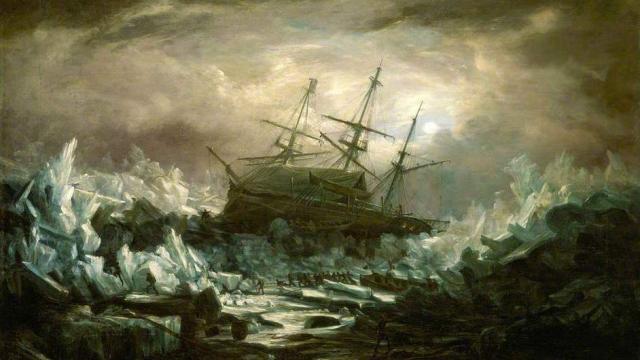The Franklin Expedition, a 19th-century mission to chart a fabled northwest passage from the Atlantic to the Pacific ocean, ended in the deaths of all 128 crewmen. A prevailing theory suggests lead poisoning was a major contributor to the sailors’ ultimate demise—a theory that can finally be put to rest, according to new research.
In 1845, two British ships, the HMS Erebus and HMS Terror, set sail for the frigid waters of the North American Arctic. The purpose of the mission, led by Sir John Franklin, was to discover and chart a potential corridor through the Northwest Passage, connecting the Atlantic and Pacific Oceans. Tragically, none of the 128 crew members survived the expedition, and the mystery of their deaths has endured for nearly 175 years.
During the first winter, the crew took shelter on Beechey Island, where three sailors died and were buried. The expedition resumed in the spring of 1846, but by September the ships had become hopelessly trapped in ice near King William Island. Incredibly, the crew stayed with their ships until April 1848, at which time the remaining 105 crewmen finally abandoned the Erebus and Terror, heading south on foot in hopes of finding aid. No one survived.
Over the years, some of the gravesites of the sailors have been uncovered, containing well-preserved bodies, and both ships have been discovered by Canadian archaeologists; was discovered in 2016 in Terror Bay. Many questions remain about the final months and days of the expedition, including the ways in which the sailors perished.
Previous analyses of the bone, hair, and soft tissue from the recovered bodies, along with oral accounts from indigenous peoples, suggested the crewmen died from an assortment of causes, such as lead poisoning, exposure, starvation, scurvy, botulism, tuberculosis, and Addison’s disease (a form of adrenal insufficiency brought on by tuberculosis).
Lead poisoning, in particular, was seen as a major contributor to the sailors’ deaths, who may have been exposed to lead from tin cans and possibly the ships’ water filtration system. And indeed, previous studies did uncover unusually high levels of lead in some of the skeletal remains, but many questions remained unanswered, such as source of the lead and the level and duration of exposure. To complicate matters, lead exposure was common in the 19th century, so while the lead within the skeletal remains seemed high, it’s not known how these levels compared to other sailors in the British navy during the same period.
New research published today in PLOS One delves further into this particular issue, concluding that lead poisoning did not play a pivotal role in the deaths of the Franklin Expedition sailors. To reach this conclusion, a research team from MacEwan University in Edmonton, Lakehead University in Thunder Bay, and several other Canadian institutions examined three hypotheses.
First, those who survived longer should’ve exhibited more extensive uptake of lead, as evidenced by microstructures found within their bones. Second, the bone that formed during the final days and months of the sailors’ lives should’ve exhibited elevated levels of lead. And lastly, if the lead was a contributing factor, bone samples should contain higher or more sustained levels of lead compared to a contemporaneous and relevant sample group—namely a 19th-century British naval population that was living in Antigua around the same time. Archaeologists recently conducted excavations of this Caribbean site, looking into whether rum and the way it was distilled, may have been a cause of lead poisoning among the members of the British navy. This data made it possible to do a comparative analysis with the Franklin Expedition.
To test these conjectures, the researchers used a high-resolution scanning technique known as confocal X-ray fluorescence imaging. This technique produces 3D images of materials, such as bone, down to a resolution of 20 microns.
Looking at the data, the researchers could not find any evidence to support the assertion that those who lived longer had more exposure to lead. The second hypothesis, that bone formed in the final days of the crew’s lives should contain elevated lead levels, “was only partially supported in that evidence indicated [lead] exposure but it was not markedly elevated for most individuals,” as the researchers write in their study. Finally, the comparative analysis with the Royal Navy remains from Antigua “did not support the hypothesis that the Franklin sailors were exposed to an extraordinarily high level of [lead] for the time.”
Taken together, the researchers concluded that “the skeletal microstructural [lead] distribution data do not support the conclusion that [lead] played a pivotal role in the loss of Franklin and his crew.”
Russell Taichman, a professor at the University of Michigan in the Department of Periodontics and Oral Medicine and an expert on the various ailments afflicting the members of the Franklin Expedition, told Gizmodo that the new paper was “very well done,” and the “controls were good and the conclusions justified.” Taichman, who wasn’t involved in the study, found it “very interesting” that “lead poisoning was not ubiquitous as a cause of widespread failure,” but he believes the paper presents some findings “which leave more to be done.” For example, he said, “some of the samples had much higher lead levels than others—why? A clear answer is not known. It leaves room for more investigation.”
As to what ultimately killed the sailors, it’s not too difficult to imagine.
“I would suspect that their problems probably multiplied as time went by,” Tamara Varney, a co-author of the new study and a member of Lakehead’s anthropology department, told the CBC. “Their food would have been limited, so they would have been starving. They would have had nutritional deficiencies. And any health problems individuals would have had going into the expedition that maybe weren’t a problem at the time, I imagine as time went on those would have become more magnified and manifest.”
In other words, they died a slow, miserable death. It was certainly a rough time to be a sailor—especially on trips to the Canadian Arctic.
[PLoS One]
